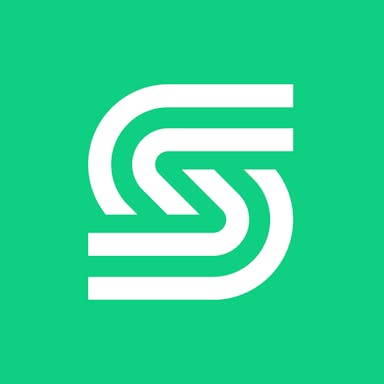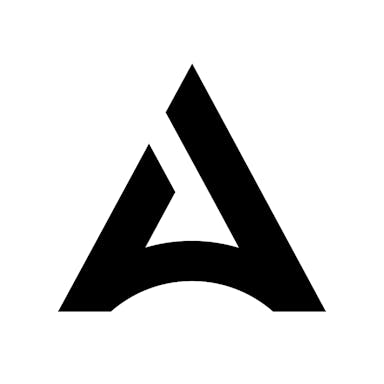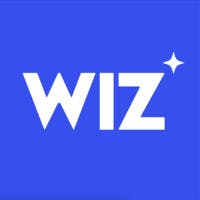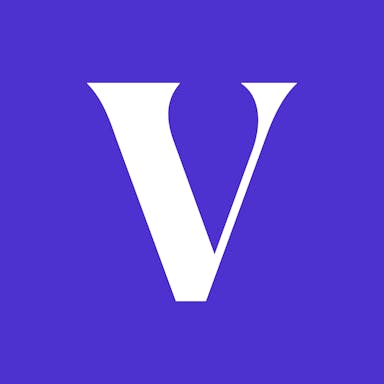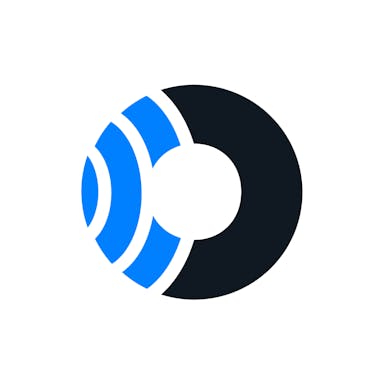Thesis
Companies are demanding higher security and compliance standards from software vendors due to the increasing prevalence of data security threats. In 2023, there were more than 2.3K data breaches caused by cyberattacks, surpassing the previous record of 1.9K from 2021 for all types of data compromises in a single year globally. A threat report published in 2023 found that the average cost of a data breach amounted to nearly $5 million per incident. The increasing shift from on-premise to cloud-based software systems is also making sensitive data more accessible remotely as 81% of companies experienced a cloud security-related incident in 2022.
Companies employ cybersecurity measures such as firewalls, stronger passwords, and multi-factor authentication to combat breaches. While these methods are effective at reducing cybersecurity risks, reliance on third-party software vendors, especially small companies with limited cybersecurity resources, remains a vulnerability. A hacker that successfully infiltrates a software vendor can gain access to the information of all its customers, meaning a single breach can threaten thousands of organizations. A 2022 Verizon investigation found that 62% of all data breaches originated from attacks on third-party dependencies, and as of February 2024, 98% of organizations had a relationship with a vendor that experienced a data breach since 2022.
The increase in sensitive data processing, as 75% of companies retain an increasing amount of sensitive data according to a 2024 report, also raises concerns about the invasion of privacy. As a result, some markets necessitate software vendors to meet certain standards to sell their products. For example, European companies failing to meet the data privacy guidelines set by the European Union's General Data Protection Regulation (GDPR) can face penalties of 20 million euros or 4% of their annual revenue.
Many procurement teams, especially those in B2B and SaaS companies, won't approve contracts with new software vendors unless they can demonstrate they’ve passed a System and Organization Controls 2 (SOC 2) audit, security questionnaire, or similar. The importance of online security and data privacy is growing as businesses receive continual exposure to various evolving sources of risks from vendors' cyberattacks. Despite increasing customer demand for vendor adherence to compliance standards, the process of becoming compliant remains manual and slow, resulting in labor-intensive processes, inefficiencies, and data inconsistencies. For instance, the average timeframe to complete readiness, remediation, and document collection phases for first-time SOC 2 audits is 12 months.
Secureframe is a platform that automates the compliance process for more than 40 frameworks out-of-the-box, including SOC 2, ISO 27001, HIPAA, PCI DSS, CMMC 2.0, and NIST standards. Secureframe enables an organization to implement and continuously maintain rigorous security and compliance controls and processes in weeks rather than months without having in-house security and compliance expertise. Secureframe offers over 300 comprehensive software integrations that automate compliance evidence collection and continuous monitoring by pulling configuration data of systems and displaying compliance results. In 2023, Secureframe reported $20 million in ARR and platform adoption by thousands of organizations including startups and high-growth companies. In some cases, Secureframe was able to save compliance teams hundreds of hours of time and effort.
Founding Story

Source: Secureframe
Secureframe was founded in 2020 by Shrav Mehta (CEO).
The initial idea for Secureframe came from Mehta’s time working at Lob, a direct-mail service startup, in 2014. At Lob, Mehta dealt with issues surrounding security and compliance due to working with sensitive data, which meant he had to complete exhaustive security questionnaires and reviews while working there. Although Mehta went on to work at Pilot and Scale AI after leaving Lob in June 2017, he continued to help other companies manage their compliance certification processes on an informal basis. While doing this, Mehta put together checklists to streamline the process of meeting security compliance standards that were not only used by the companies he worked for but also their partners, which he says was effectively “the first version” of Secureframe.
Secureframe started as a solution to ease the friction of SOC 2 compliance. Secureframe's earliest traction came from Mehta’s existing network, where people reached out to him asking for SOC 2 compliance templates. In a July 2024 interview, Mehta recalled on the formation of Secureframe:
“We were exploring different ideas within the world of software security and I started asking people in my network if they would be interested in tools to automate some of the SOC 2 compliance process. Many people said yes, but I didn’t really know how serious they were. One person I talked to called me back a month later and asked where the product was. I quit my job that week and started building the minimum viable product (MVP) for what is now Secureframe.”
By the time the first version of the product was ready, there were already 30 to 40 potential customers, who wanted to use the product despite not having yet seen the software. As of November 2024, Secureframe’s product coverage has expanded to include more than 40 frameworks, including ISO 27001, HIPAA, GDPR, PCI DSS, NIST standards, and many federal and regulatory standards.
Product
Secureframe is an end-to-end security compliance automation platform that allows businesses to streamline their audit, risk, and compliance processes and strengthen their security posture for prospective end customers. Secureframe’s integrations and features reduce the amount of time employees need to spend on labor-intensive pre-audit tasks including interpreting framework requirements, conducting gap assessments, and remediating findings. Secureframe integrates with more than 300 commonly used cloud and SaaS tools to scan for compliance-related issues and displays the results and remediation guidance in the platform, reducing a process that normally takes months down to a few days in some cases.
Secureframe Comply
Secureframe’s compliance automation platform provides tools that encompass every need a company requires to prepare for an audit or set up security controls to be in line with industry frameworks and custom frameworks. Comply also includes automated evidence collection, control testing, policy management, and a suite of vendor and risk management features. Comply also detects cloud misconfigurations and leverages AI to generate tailored remediation guidance.
Integrations & API
Through over 300 integrations with services like AWS, Asana, Azure, Google, Github, Rippling, and Slack, Comply automatically collects audit evidence and monitors cloud infrastructure for nonconformities to automate the evidence collection process and drive continuous compliance.
Secureframe API allows organizations to integrate compliance automation directly into their workflows and systems. Through this API, users can manage various compliance tasks, including monitoring security controls, tracking audit logs, automating evidence collection, and assessing risks. It enables programmatic access to data relevant to security compliance processes, which can streamline tasks like generating reports and ensuring continuous compliance with standards like SOC 2, ISO 27001, and GDPR. This integration is particularly useful for developers and IT teams aiming to embed compliance management features into their own applications or internal tools.
Frameworks
Secureframe's frameworks page provides a centralized overview of compliance standards that Secureframe supports, offering details on each framework's requirements and guidelines to help organizations understand and manage their security and compliance obligations. Organizations set these requirements through controls, and tests prove that a customer is adhering to the set requirements.

Source: Secureframe
Comply’s automated workflows cover SOC 2 and ISO 27001 for companies to meet information security standards, HIPAA for health data standards, PCI DSS for financial information regulations, GDPR for data privacy standards, NIST standards, CMMC, CJIS, and TX-RAMP for federal contractors, as well as custom enterprise frameworks. The Frameworks page in Comply provides a unified page to review progress toward security audits and allows customers to track how closely they are following guidelines in real time.
For any individual framework, customers can review passing and failing controls and assign them to relevant owners in a single dashboard. Customers can also combine specific security controls, processes, and policies to reflect unique requirements, industry standards, and regulatory obligations through custom frameworks. Custom frameworks enable businesses to map pre-built controls and tests to unique compliance scenarios.

Source: Secureframe
SOC 2 Automation: SOC 2 is a cybersecurity compliance framework for service and technology providers that manage customer data. SOC 2 standards encourage organizations to build robust security processes that protect user data and build trust. There are two types of SOC 2 compliance: SOC 2 Type 1 evaluates a company’s data security posture at a point in time and can be completed within a few weeks and SOC 2 Type 2 assesses the quality of security processes over a longer period of 3 to 12 months.
Secureframe’s SOC 2 automation condenses more than 200 controls into eight steps to save users hundreds of hours of manual work. Customers using Secureframe can work with a dedicated account manager, build SOC 2 compliance policies aligning with their business needs, assess vendor risk, initiate an audit, scan cloud infrastructure, train personnel on SOC 2 privacy requirements, and continuously monitor more than 300 cloud services for continued compliance.
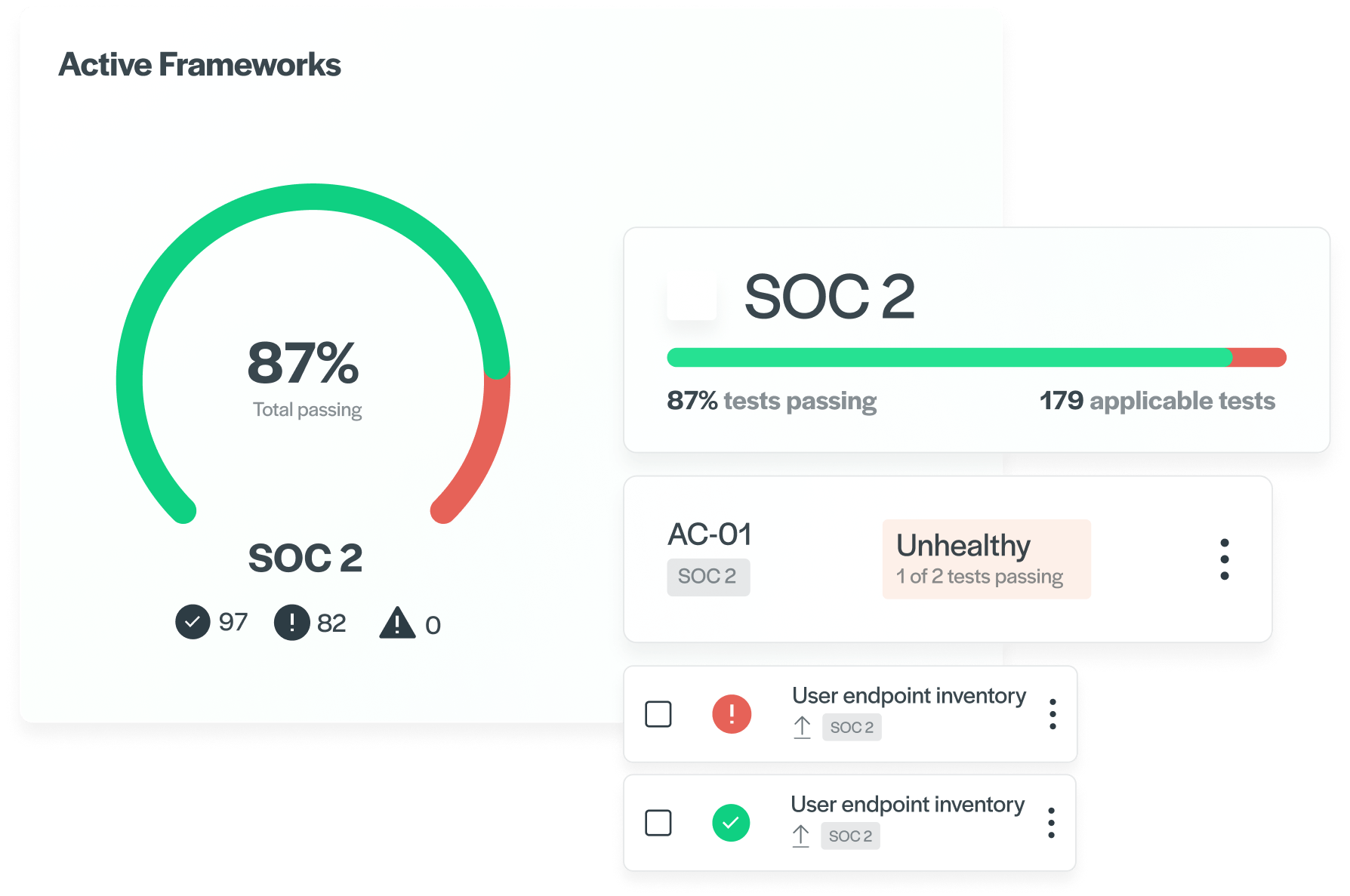
Source: Secureframe
ISO 27001 Compliance: ISO 27001 is a global standard, recognized more widely outside North America than SOC 2, that pushes organizations to establish, maintain, and continually upgrade their information security management system (ISMS) to protect customer privacy. The certification lifecycle includes multiple steps.
An auditor reviews ISMS documentation to ensure the right procedures are in place.
Auditors conduct a surveillance audit each subsequent year following initial certification. Every three years, companies with ISO 27001 certification go through a recertification audit similar to the Stage 2 audit.
Secureframe’s ISO 27001 automation helps companies design an ISMS that aligns with both the ISO 27001 framework and business goals. Users can modify policies from a library of templates and scan cloud infrastructure to monitor for ISO 27001 compliance and generate a Statement of Applicability (SoA) for their auditors.
HIPAA: HIPAA is a data privacy standard required for healthcare plans, providers, insurers, clearinghouses, biotech companies, and pharmaceutical organizations. Secureframe provides a customer support team to help companies set up HIPAA policies and train employees. Its third-party management features also ensure that vendors and business associates with access to Private Health Information keep patient information secure. Administrators can access a library of HIPAA policy templates developed and vetted by in-house HIPAA experts and guide employees through self-serve HIPAA privacy and security awareness training.
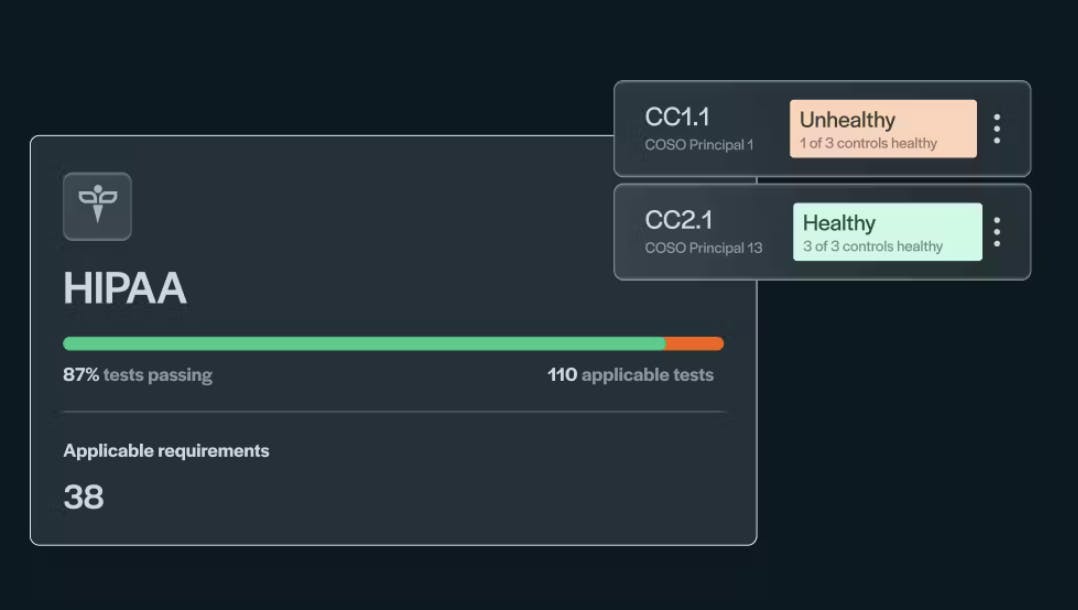
Source: Secureframe
PCI DSS: PCI DSS is a security standard for merchants and service providers that handle credit card data, ensuring that vendors are maintaining proper data security throughout the entire credit card transaction. There are four levels of PCI DSS compliance. The Report on Compliance (RoC) contains 12 requirements concerning how organizations should secure their systems to protect cardholder data. RoCs reports are valid for one year and issued through third-party audits and a control review performed by a qualified security assessor (QSA). The PCI DSS Self-Assessment Questionnaire (SAQ A) is for e-commerce or mail-order/telephone-order (MOTO) merchants that all their payment processing from a PCI DSS-validated third-party service provider. The PCI DSS Self-Assessment Questionnaire (SAQ A-EP) is for e-commerce or MOTO merchants that outsource all payment processing but still use elements originating from the merchant’s website to deliver elements of their payment pages.
Secureframe Comply supports Level 1 merchants who need a RoC by consolidating PCI DSS’s 300 control requirements all in one place. It also helps customers decide which compliance level they fall under and directs users through the RoC or SAQ workflow.
Secureframe AI
In June 2023, Secureframe announced the launch of Secureframe Comply AI, a set of AI features to assist users with maintaining compliance according to specific standards. Previously, when Secureframe detected cloud software misconfigurations, users were given step-by-step guidance to fix the issues themselves in their development consoles. Starting with AWS, Comply AI expedites the remediation process by providing faster and more accurate guidance, generating code that users can copy to quickly deploy fixes to their cloud environments, and reducing the manual work and human error of writing code when fixing misconfigurations. Comply AI also includes a chatbot to provide additional remediation details or more tailored guidance for specific security and compliance situations.
Comply AI’s feature suite also includes AI-generated risk assessment scores, an AI-powered text editor to write and refine compliance policies, auto-population of response fields in vendor review questionnaires, and suggestions to control mappings to frameworks and risk assessments.
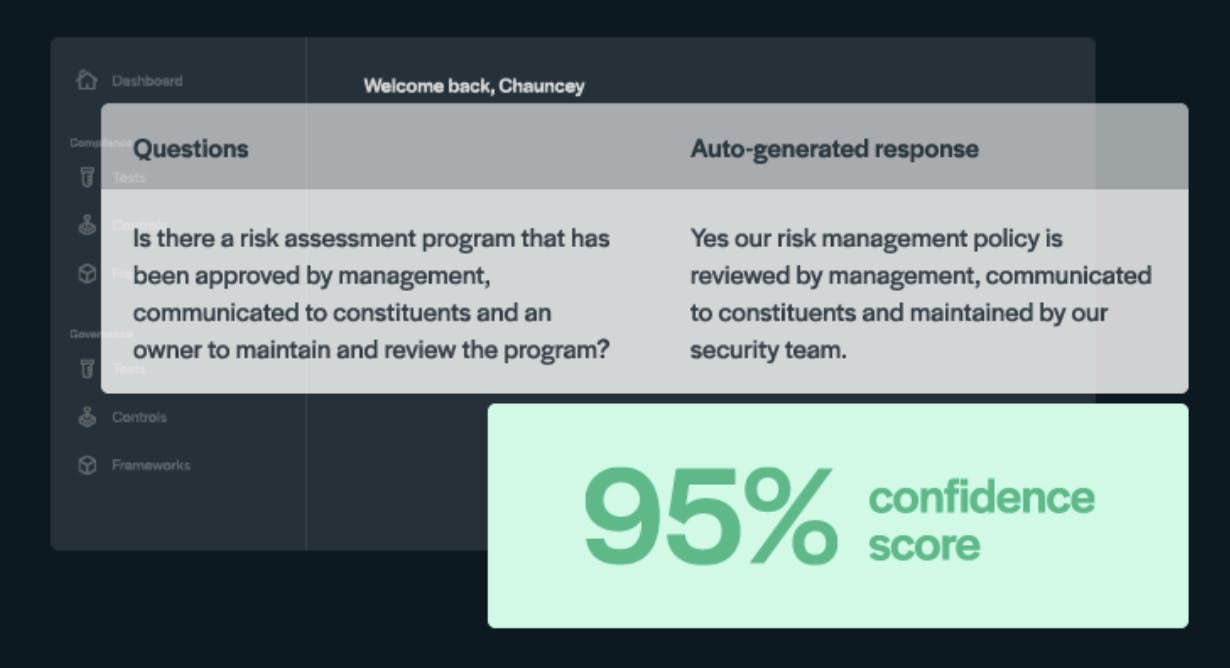
Source: Secureframe
In May 2024, Secureframe Comply AI was renamed to Secureframe AI because it added a new suite of features including the following:
Generative AI in Questionnaire Automation: This feature uses generative AI to recommend answers for security questionnaires by referencing information from each user’s Secureframe policies, control data, and knowledge base. This automation reduces time spent on lengthy questionnaires and improves accuracy by directly sourcing responses from relevant documents.
Comply AI for Vendor Risk Management: Secureframe’s AI enables organizations to send out customizable or templated security questionnaires to vendors, with responses centrally managed within the Secureframe platform. This feature further leverages AI to extract specific answers from uploaded vendor documentation, such as SOC 2 reports, which helps streamline and speed up the review process for vendor compliance.
Comply AI for Control Mapping: This functionality assists in automatically mapping controls to multiple security frameworks, including custom frameworks, which saves time by automating control setup. Customers can apply Secureframe’s automated testing capabilities to custom controls, enhancing both efficiency and accuracy.
Comply AI for Evidence Review: Secureframe’s AI can review any evidence within the platform to ensure sufficiency ahead of auditor review.
Comply AI for Policy Documentation and Management: Use AI within Secureframe’s policy management module in order to make policy documentation and management more efficient and in line with industry best practices.
AI Framework Support: Secureframe’s platform supports AI-specific frameworks, like the NIST AI RMF and ISO 42001, which provide guidelines for the responsible and secure deployment of AI systems.
These AI features collectively allow Secureframe to reduce manual workload in security and compliance management, making processes more efficient and enabling faster, more accurate compliance assessments and framework implementations.
Controls Management
Secureframe Controls is a compliance tool that provides pre-built and customizable security control frameworks for companies. It allows organizations to manage and monitor security practices through standardized controls, including access management, incident response, and data protection protocols. By centralizing these controls, Secureframe streamlines tracking and reporting, enabling teams to meet compliance requirements by continuously verifying adherence to security and privacy standards.
Policy Management
Secureframe Policy Management is a tool that enables companies to create, manage, review, approve, and distribute compliance policies necessary for regulatory standards. It provides custom policy templates, such as data protection, access control, and incident response, allowing companies to customize them to their needs. Additionally, the tool helps automate policy tracking, monitoring policy adherence, and updating policies as requirements change, ensuring companies stay aligned with industry standards and regulatory compliance requirements.
Automated Evidence Collection
Secureframe Automated Evidence Collection streamlines the gathering of data needed for audits and compliance reporting by automatically pulling evidence from various systems, such as cloud providers, HR platforms, and project management tools. The tool connects with these systems to regularly capture screenshots, logs, and other required records, reducing the need for manual collection. This functionality ensures evidence is collected consistently over time, which helps maintain readiness for audits by tracking controls and showing continuous compliance across standards like SOC 2, ISO 27001, and GDPR.
Trust Center
Secureframe allows organizations to showcase their security posture and reduce the amount of time it takes to fill out security questionnaires while selling to new customers. Users can publish their Trust Center publicly to share information about security, privacy, and adherence to compliance standards with sales prospects and customers. From Secureframe’s Trust Center, sales prospects can self-serve or request sensitive security documents from Secureframe’s customers. Administrators in an organization can manage resource requests from the dashboard as well.
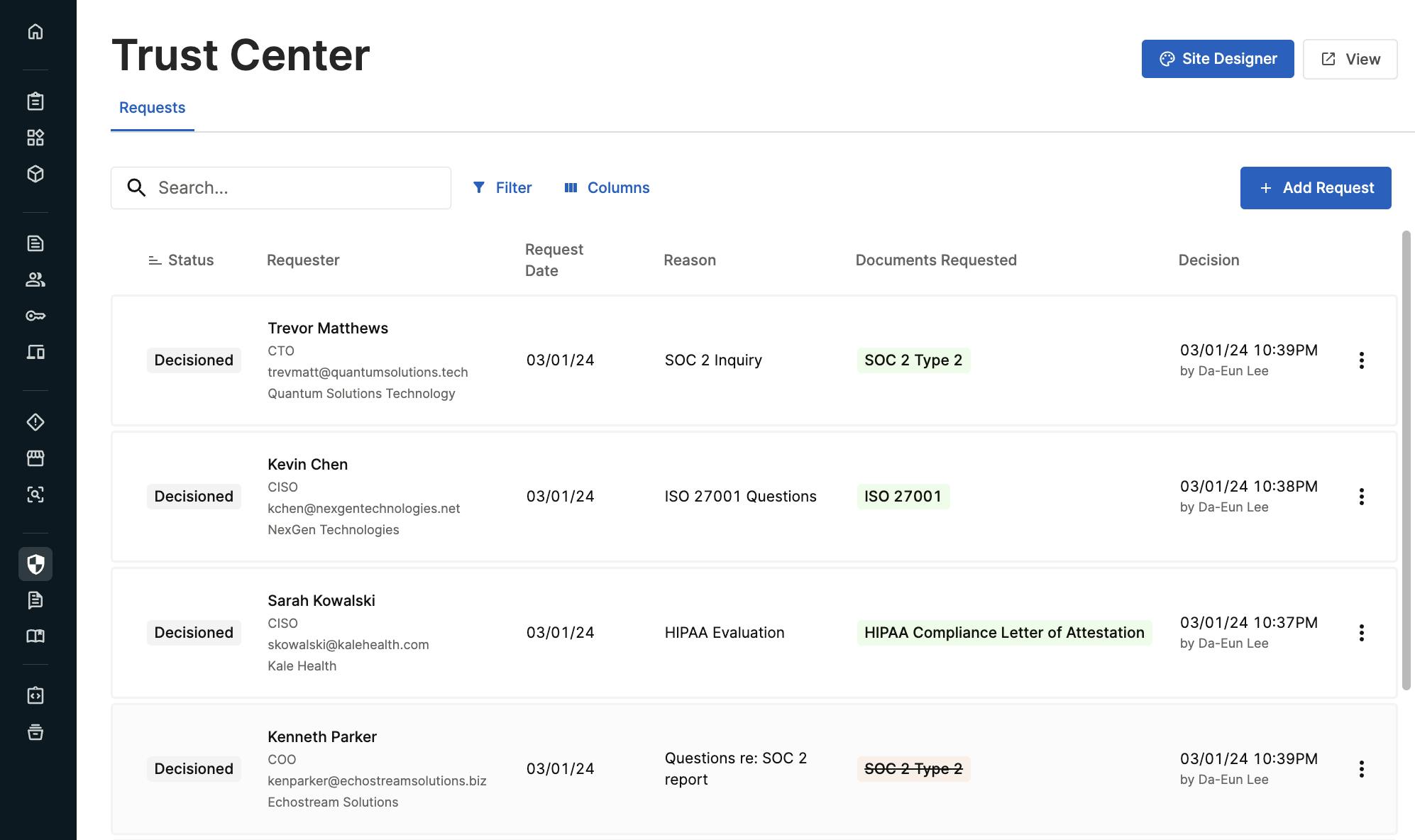
Source: Secureframe
Secureframe Trust also includes a Knowledge Base that serves as a central repository for managing an organization’s security, compliance, and technical knowledge. With its Knowledge Base Chrome extension, any employee can quickly access answers to security questions from their browser.
Risk Management
Secureframe's Risk Management platform enables organizations to identify, manage, and mitigate security and compliance risks by centralizing risk-related data and providing tools for continuous monitoring. It assesses risks across various domains, including data security, vendor management, and operational controls, allowing businesses to maintain a secure environment that aligns with regulatory standards. The platform provides real-time visibility into risk exposure and automates processes like risk assessments, tracking remediation efforts, and generating reports for audit readiness. By streamlining these processes, Secureframe’s platform helps organizations proactively address vulnerabilities and enhance their security posture while staying compliant with industry regulations.
Secureframe also includes a Third-Party Risk Management platform that enables companies to manage third-party vendor relationships through Secureframe. Administrators can use the tool to track their vendors’ security posture — gaining access to details such as vendor risk assessments, document attachments, and vendor history logs.
Personnel Management: Secureframe’s Personnel Management dashboard allows companies to track, manage, and ensure compliance among employees and contractors. Customers can import personnel through HR, SSO, or MDM integrations. Through People Management, administrators can monitor the level of access each personnel has to their company’s integrations and monitor for incomplete pre-audit tasks.
Access Management: Secureframe’s Vendor Access is designed to simplify and secure the process of managing employee access to integrated systems and technology. This tool allows companies to review individual access levels, including role and authentication status, and ensure that access is appropriately updated or revoked as employees’ roles change. With filters for access scope and audit readiness, it simplifies audit compliance by allowing direct verification of access requirements across systems.
Training: Secureframe Training automates training for SOC 2, HIPAA, PCI DSS, GDPR, and more. These compliance frameworks require employee training to ensure personnel are up-to-date on security best practices. Through the training portal, companies can issue assignments and track employee progress through educational modules. This tool also offers custom scheduling and regular updates, which help organizations maintain compliance readiness and mitigate risks associated with human error in data protection and privacy practices.
Market
Customer
Security compliance is a mission-critical and laborious process that nearly all software companies go through. Many companies require compliance reports and certifications such as SOC 2 and ISO 27001 from software vendors before they will do business with them. Any online merchant needs to meet PCI DSS compliance to work with credit card processors. Nearly all healthcare entities are required by law to follow HIPAA standards.
Secureframe distinguishes its customer base into two categories: small business and enterprise. As of November 2024, Secureframe had more than 3K customers including Coda, AngelList, Smartcar, Lyra, Nasdaq, Ramp, Remote, and Generali.
Small Businesses: Small businesses face constraints in managing cybersecurity standards and audit requirements internally, including low awareness, inadequate technical protection, lack of defined processes, and compliance issues. Secureframe’s automation of tasks like evidence collection, policy management, and control tracking helps small organizations meet regulatory standards such as SOC 2, ISO 27001, and HIPAA. This setup allows small companies to prepare for audits and demonstrate compliance without the need for substantial compliance resources.
Enterprises: Secureframe’s enterprise customers benefit from its platform as it helps them manage large-scale compliance needs across multiple frameworks while ensuring consistency in policy management and control implementations across departments. Its offerings enable larger organizations to streamline these workflows, manage compliance centrally, and monitor their security and compliance posture in real time. It also allows enterprises to integrate with their existing technology stack and eliminate duplicative work from multiple frameworks. This approach helps enterprises maintain compliance across their larger infrastructures and varied operations.
Market Size
The US enterprise governance, risk, and compliance market was valued at $13.3 billion in 2023 and is projected to grow at a CAGR of 11.2% from 2024 to 2030. The global enterprise governance, risk, and compliance market was valued at $38.4 billion in 2023 and is projected to grow to $111.3 billion by 2032 at a CAGR of 12.4%. Companies are increasingly mandating that their vendors follow strict compliance protocols, and as data requirements become more complex and expansive, demand for compliant software is increasing. A 2022 threat report found that insider threat incidents rose by 44% between 2020 and 2022 while costs of credential theft to organizations grew by 65% in the same period.
A survey conducted in 2023 found that 62% of organizations used some software to monitor security controls and build reports on their compliance postures. 69% of organizations surveyed expected to increase spending on IT compliance and risk management in 2024.
Competition
Vanta: Founded in 2017, Vanta is an automated security monitoring platform that helps companies get SOC 2, HIPAA, or ISO 27001 certified. Vanta and Secureframe both offer platforms that help businesses streamline compliance management, providing tools for automating security processes and managing frameworks like SOC 2 and ISO 27001, which makes them direct competitors in the security and compliance automation market.
Backed by Y Combinator and Sequoia Capital, Vanta reached $10 million in ARR across more than 3K customers in 2021. In 2022, Vanta reported serving over 4K companies across 58 countries. In January 2024, Vanta announced that it surpassed $100 million in ARR across 8K customers, doubling its global customer base from 2022. As of November 2024, Vanta has raised a total of $353 million in funding. Vanta’s last round was a $150 million Series C in July 2024 that valued the company at $2.45 billion.
Drata: Founded in 2020, Drata is a security and compliance automation platform that helps companies streamline their compliance processes for frameworks such as SOC 2, HIPAA, GDPR, and ISO 27001. Drata and Secureframe both offer platforms focused on simplifying compliance processes by automating tasks related to frameworks like SOC 2 and ISO 27001, targeting organizations that need streamlined security and audit preparation.
Backed by GGV Ventures and ICONIQ Growth, Drata acquired its first 100 customers within 45 days of launch and grew revenue at 69% month-over-month in its first 10 months. By 2022, Drata had expanded to support 13 additional compliance frameworks and reached over 2K clients. As of November 2024, Drata has raised a total of $328.2 million in funding. Its most recent round was a $200 million Series C in December 2022, which valued it at $2 billion. Drata offers over 100 integrations and has been recognized as a Momentum Leader in Cloud Compliance, Vendor Security and Privacy Assessment, and IT Asset Management by G2.
Business Model
Secureframe has a flexible pricing model that varies depending on the number of personnel, frameworks, and other add-ons included in the organization’s Secureframe instance.
Secureframe offers two pricing packages: Fundamentals and Complete. Fundamentals includes all compliance automation features, including automated evidence collection, continuous monitoring, policy management, security awareness training, and much more. It also includes key capabilities from Secureframe’s end-to-end Risk Management Module, Third-Party Risk Management solution, Questionnaire Automation, and Trust Center. The Complete package includes everything in Fundamentals plus:
Advanced Questionnaire Automation
Advanced Third-Party Risk Management
Advanced Trust Center
SSO & SCIM Connections
Advanced Risk Management
Additional Workspaces (add-on)
Below is a sample pricing scheme for a company with 100 employees. The Secureframe Platform SKU must be purchased in order to purchase a Framework. Customers with less than 10 employees are eligible for additional discounts, and customers purchasing multiple frameworks can receive special discounts.
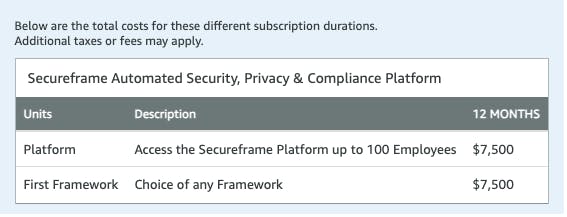
Source: Secureframe
Traction
During 2021, Secureframe grew its revenue by 10x and its customer base by 7x, adding customers like Instabase, Stream, and Dooly. By February 2022, Secureframe had grown its team to 80 people, expanded its executive team, added additional compliance frameworks like ISO 27001, HIPAA, and PCI DSS, launched more than 100 integrations with business apps and established partnerships with companies like Plaid to work on security frameworks with the Open Finance Data Security Standard (OFDSS). A survey indicated that, as of December 2024, Secureframe customers experienced a 26.7% decrease in compliance costs. The same survey indicated that 86% of customers surveyed reported reduced time and effort required to maintain compliance, with saving 5.8 hours per week on average.
In October 2023, Secureframe reported $20 million in ARR with customers including Coda, AngelList, Nasdaq, Smartcar, Lyra, Ramp, and Remote. As of November 2024, Secureframe had grown to more than 200 employees with offices in San Francisco, New York, Austin, Denver, Toronto, and London and has also added over 150 integrations.
Valuation
In February 2022, Secureframe raised a $56 million Series B led by Accomplice with participation from investors including Kleiner Perkins, Optum Ventures, and Kaiser Permanente while Michael Viscuso, the founder of Carbon Black, joined the board. As of November 2024, it has raised $79 million in total funding at an undisclosed valuation. In October 2020, Secureframe raised a $4.5 million seed round led by Base10 Partners and Gradient Ventures with participation from BoxGroup, Village Global, Soma Capital, Liquid2, Chapter One, Worklife Ventures, and Backend Capital. In March 2021, it raised an $18 million Series A led by Kleiner Perkins with participation from Gradient Ventures and Base10 Partners.
Key Opportunities
Security and Privacy Regulations
The proliferation of local and international standards for data protection, security, and privacy are likely to be more ubiquitous and standardized over time to meet the growing cybersecurity threat on digital platforms. New regulations and continuously evolving security frameworks create strains on growing companies and siphon away employees from more productive areas in an organization. As the compliance burden expands, companies are likely to increasingly turn to automated compliance solutions to streamline their security posture workflows.
Increase in Data Breaches
A historic increase in data breach cases is making companies acutely aware of the importance of both maintaining strong cybersecurity best practices and choosing secure vendors. 2023 was a record year for data breaches, with 80% of data breaches involving data stored in the cloud. The number of data breaches in the US rose to a record 3.2K in 2023, a 78% increase compared to 2022. Notable data breaches like SolarWinds, Equifax, and the Colonial Pipeline ransomware attack have shown corporate executives the importance of building a robust security posture preemptively.
Distributed Teams and Increasing Security Complexity
Distributed teams have more complex digital footprints than in-person teams. With the increase of remote and hybrid work environments, enterprises must invest more diligently in their security models. A Gallup poll found that 53% of US employees were hybrid as of May 2024. 42% of US IT workers were remote in 2022. The growing complexity of managing workers’ digital presence necessitates adopting an all-in-one compliance solution.
Key Risks
Regulatory Environment
Compliance is a constantly evolving field as “with each passing year, the regulatory framework undergoes constant revisions and updates, posing new challenges for businesses striving to stay ahead of the curve.” The interplay between state and federal compliance laws may also present a challenge to keeping up with additions and changes. Changes in compliance law could require reconstructing policy templates in Secureframe’s library, potential product changes, and in-house expertise. In 2023, eight new states enacted new consumer privacy laws, and in early 2024, four states signed comprehensive privacy laws.
Competitive Landscape
Secureframe is competing with other fast-growing startups and incumbents capable of subsidizing their compliance products. Competitors such as Vanta and Drata are also focused on streamlining compliance processes and often offer overlapping features like continuous monitoring, audit readiness, and automated workflows. As more players enter the market, customers have a wider range of options, which could lead to price pressure, the need for constant innovation, and a push to differentiate through customer support, integrations, or added features. This competition could impact Secureframe’s ability to capture and retain market share, especially if competitors invest aggressively in product development or partner with strategic service providers.
Vendor Consolidation
As a result of interest rate hikes and pressures to improve business margins, CTOs are looking for solutions that help consolidate spending. The industry preference is gradually evolving from a constellation of software vendors providing specific point solutions to bundled multi-product platform businesses. Larger businesses are looking for vendors that integrate across diverse software environments from endpoint to cloud.
Palo Alto Networks is one example of this trend on the vendor side. Since 2014, Palo Alto Networks evolved from a network security tool to a broader cybersecurity platform with multi-product offerings stemming from its 21 acquisitions as of November 2024. Consequently, it may be difficult for Secureframe to win procurement bids against entrenched companies offering the same product as part of a larger ecosystem.
Summary
Amidst growing cyber security threats, high business costs associated with data breaches, and reliance on sensitive customer data to conduct business, companies are increasingly investing in their enterprise security postures. More and more enterprises require their vendors to follow certain cybersecurity compliance frameworks or are required to demonstrate adherence to certain standards to operate. This process is traditionally manually time-consuming. Secureframe offers an end-to-end platform to automate compliance tasks ranging from common frameworks like SOC 2 or HIPAA to custom enterprise policies so that customers can focus their time on their core business offerings.
